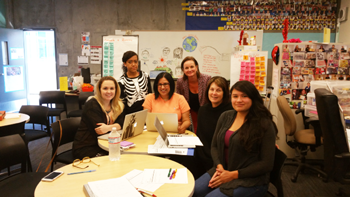 SDWP’s out-of-school youth outreach project was selected as a winning proposal to be presented at the White House Learning Exchange and Discussion on September 19, 2016.
SDWP’s out-of-school youth outreach project was selected as a winning proposal to be presented at the White House Learning Exchange and Discussion on September 19, 2016.
Of the 80 teams who entered this challenge, SDWP is one of only 15 teams selected for this final phase.
Each proposal was evaluated by a team of workforce professionals from multiple agencies, led by the U.S. Department of Labor Employment and Training Administration, in five categories — coursework, partnerships, participation, project proposal and sustainability strategy.

 Those who participated in the project included SDWP youth program specialists Sandra Bauler, Amanda Cheyney and Crystal Gunter, in-school and out-of-school-youth, representatives from San Diego Continuing Education, San Diego City College, San Diego Housing Commission, YouthBuild, JobCorps, Impact Without Borders, FY17 WIOA-funded youth service providers and Sharp HealthCare. The younger members of the team named the group H.Y.P.E., which stands for Helping Youth Pursue Excellence.
Those who participated in the project included SDWP youth program specialists Sandra Bauler, Amanda Cheyney and Crystal Gunter, in-school and out-of-school-youth, representatives from San Diego Continuing Education, San Diego City College, San Diego Housing Commission, YouthBuild, JobCorps, Impact Without Borders, FY17 WIOA-funded youth service providers and Sharp HealthCare. The younger members of the team named the group H.Y.P.E., which stands for Helping Youth Pursue Excellence.
While the idea of customer-centered design is not new to business, it has only recently taken hold in the nonprofit and government sectors. The initiative by the Department of Labor aims to simplify processes to make sure the agency focuses on doing things that will benefit the end user. In San Diego, the team focused on championing best practices with out-of-school youth, which often means including the very people in discussions about the programs that would be serving them.
During the inspiration phase, the team started with the general question proposed by the Department of Labor, “How might we design services and programs for out-of-school youth that will engage them and produce great outcomes?” During this phase the team collected thoughts, reviewed what they already knew, defined what they didn’t know and reviewed constraints and barriers. As a result, the team refined its questions, leading to “How might we connect out-of-school youth with opportunities that meet their needs?” and “How might we help youth with costs related to enrollment/engagement in programs?” As a result of various iterations of the customer-centered design process, our current question is “How might we outreach to out-of-school youth through family and peer-to-peer connections?”
“The customer-centered design process takes longer than traditional practices,” says team lead Bauler. “But in the end it is more effective,” because it takes into consideration the end user’s needs.
The result of the project was a Peer-to-Peer Guide for hiring and training Peer-to-Peer Ambassadors. The team facilitated a customer-centered design session with newly funded WIOA Title I youth service providers, serving out-of-school youth in San Diego. The goal was to share the process and outcomes. The team shared themes and insights, facilitated a panel of youth and youth service providers to begin the dialogue to test assumptions on outreach and recruitment strategies and shared their Peer-to-Peer Guide to obtain feedback. The team demonstrated the customer-centered design process and how to apply these principles to their daily work.
In collaboration with SDWP’s Communications team and 2-1-1 San Diego, the team hosted another customer-centered design workshop focused on outreach and communication.
Presenting this project at the White House will be Bauler, Cheyney, and youth participants Ana Karina Lomeli-Cadenas and Kenia Valence-Galeana, both Price Scholars attending San Diego City College.
Cheyney sums up what customer-centered design means to her, saying “It is everything you do — focusing on the people you’re serving, practicing empathy, being open to feedback, not waiting until things are perfect, using feedback to continuously try different things, being open to listening to customers — in their spaces, in their shoes.”
